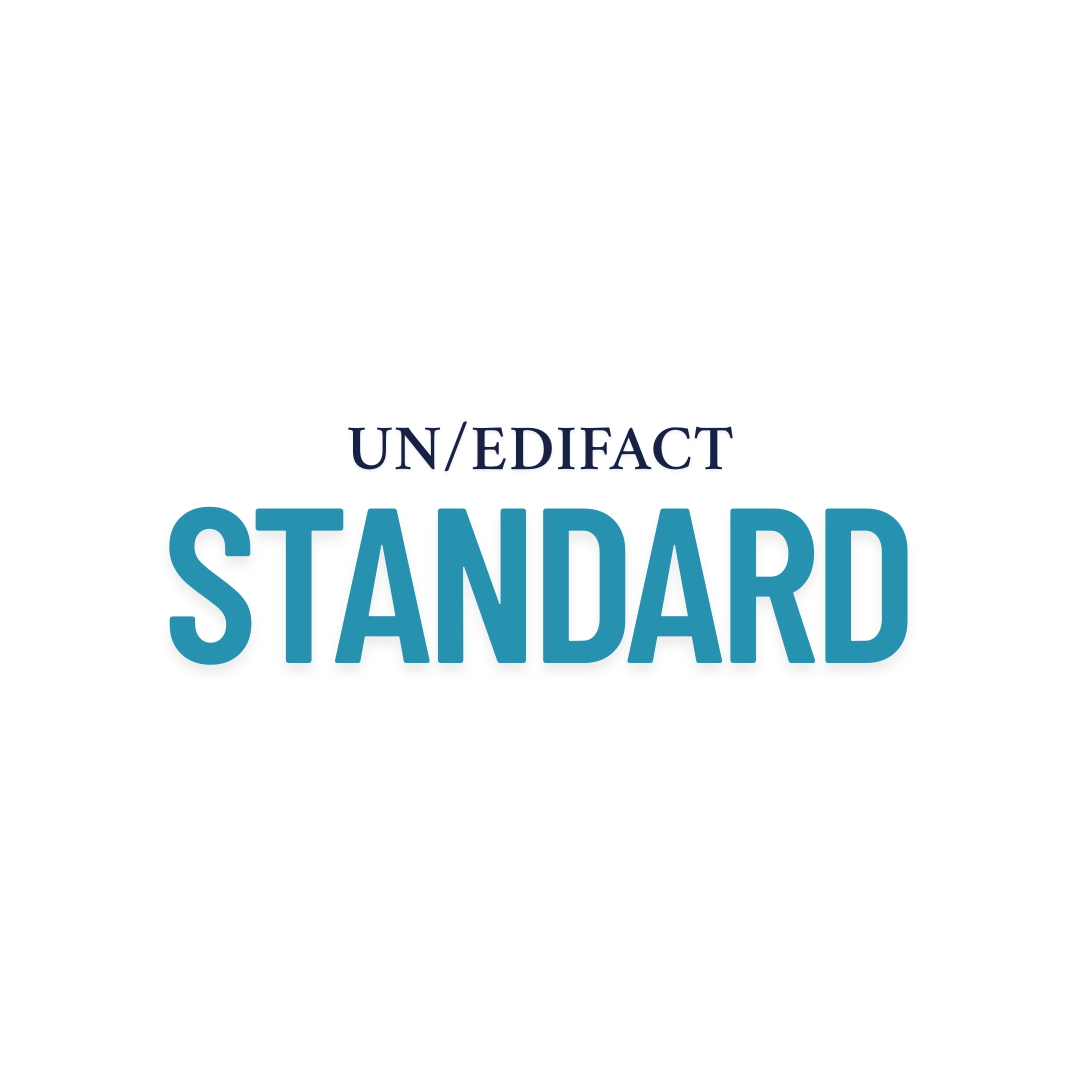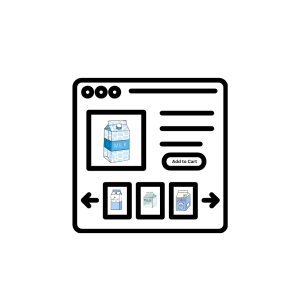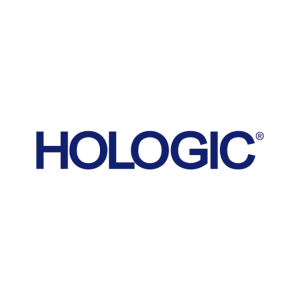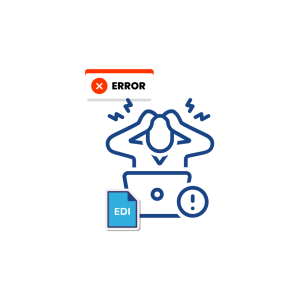Introduction
UN/EDIFACT (United Nations/Electronic Data Interchange for Administration, Commerce, and Transport is the international standard that was developed by the United Nations). Comprise a set of internationally agreed standards, directories, and guidelines for the electronic interchange of structured data, between independent computerized information systems. The work of maintenance and further development of this standard is done through the United Nations Center for Trade Facilitation and Electronic Business (UN/CEFACT) under the UN Economic Commission for Europe.
EDIFACT has served as the default international EDI standard for several decades and is largely used throughout Europe.
EDIFACT Message Structure
An EDIFACT message represents a single business document. – For example, an ORDRSP file represents a Purchase Order note. Each message has a six-letter identifier that shows the short name of the message.
Any document in the UN / EDIFACT standard has a hierarchical structure. The entire electronic document is called a message. A message consists of data groups combined in some way, for example, a data group describing customs payments, a group of data describing the attributes of documents, etc. In turn, the group consists of typical data segments that describe document attributes in more detail. The standard provides about 200 different types of segments from which messages are composed. The segments themselves also have a hierarchical structure and consist of data elements that can be simple (data field) and composite (usually 2-3 data fields).
The following is the structure of an EDIFACT transmission:
- Service String Advice
- Interchange Header
- Functional Group Header
- Message Header
- User Data Segments
- Message Trailer
- Functional Group Trailer
- Interchange Trailer
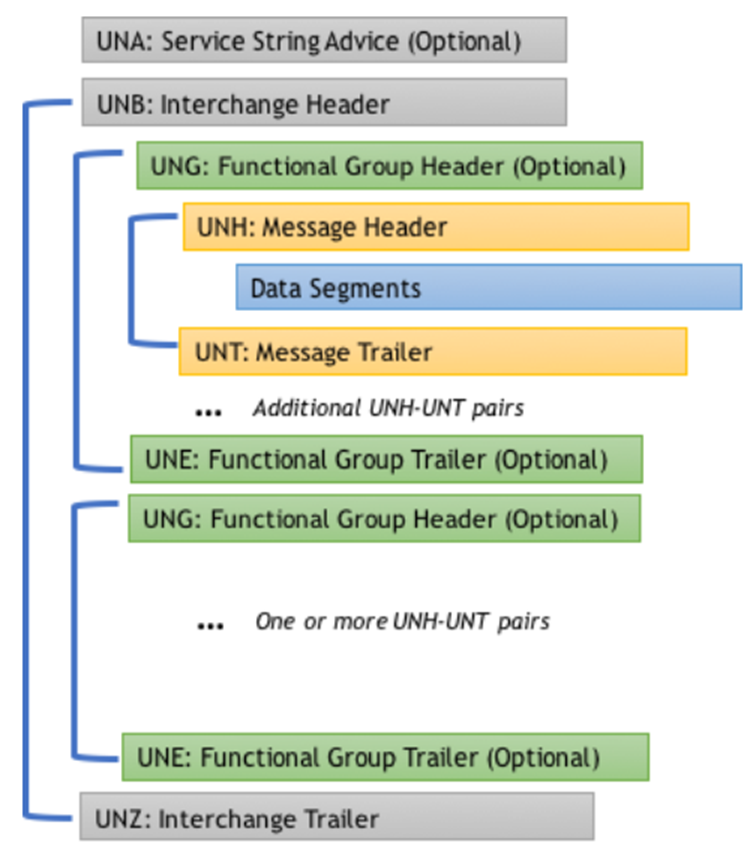
Benefits of UN/EDIFACT
UN/EDIFACT allows real-time electronic transactions and accelerates the interactions between trading partners.
3 main benefits of UN/EDIFACT standards are,
- Accuracy – Eliminates human errors that are inevitable when manually entering the data
- Improve Cashflow – Reducing paper-based processing will in turn reduce your business administrative costs and save thousands of dollars for business
- Efficiency – Large volumes of data can be transferred within minutes thus improving overall operational efficiency
See below for an example of an EDIFACT message used to answer a flight ticket (FRA-JFK-MIA) availability request:
UNA:+.? ‘
UNB+IATB:1+6XPPC:ZZ+LHPPC:ZZ+940101:0950+1′
UNH+1+PAORES:93:1:IA’
MSG+1:45′
IFT+3+XYZCOMPANY AVAILABILITY’
ERC+A7V:1:AMD’
IFT+3+NO MORE FLIGHTS’
ODI’
TVL+240493:1000::1220+FRA+JFK+DL+400+C’
PDI++C:3+Y::3+F::1′
APD+74C:0:::6++++++6X’
TVL+240493:1740::2030+JFK+MIA+DL+081+C’
PDI++C:4′
APD+EM2:0:1630::6+++++++DA’
UNT+13+1′
UNZ+1+1′
| Application Reference | Message Type |
| APERAK | Application error and acknowledgement message |
| AUTHOR | Authorization message |
| AVLREQ | Availability request – interactive message |
| AVLRSP | Availability response – interactive message |
| BALANC | Balance message |
| BANSTA | Banking status message |
| BAPLIE | Bayplan/stowage plan occupied and empty locations message |
| BAPLTE | Bayplan/stowage plan total numbers message |
| BERMAN | Berth management message |
| BMISRM | Bulk marine inspection summary report message |
| BOPBNK | Bank transactions and portfolio transactions report message |
| BOPCUS | Balance of payment customer transaction report message |
| BOPDIR | Direct balance of payment declaration message |
| BOPINF | Balance of payment information from customer message |
| BUSCRD | Business credit report message |
| CALINF | Vessel call information message |
| CASINT | Request for legal administration action in civil proceedings message |
| CASRES | Legal administration response in civil proceedings message |
| CHACCO | Chart of accounts message |
| CLASET | Classification information set message |
| CNTCND | Contractual conditions message |
| COACSU | Commercial account summary message |
| COARRI | Container discharge/loading report message |
| CODECO | Container gate-in/gate-out report message |
| CODENO | Permit expiration/clearance ready notice message |
| COEDOR | Container stock report message |
| COHAOR | Container special handling order message |
| COLREQ | Request for a documentary collection message |
| COMDIS | Commercial dispute message |
| CONAPW | Advice on pending works message |
| CONDPV | Direct payment valuation message |
| CONDRA | Drawing administration message |
| CONDRO | Drawing organization message |
| CONEST | Establishment of contract message |
| CONITT | Invitation to tender message |
| CONPVA | Payment valuation message |
| CONQVA | Quantity valuation message |
| CONRPW | Response of pending works message |
| CONTEN | Tender message |
| CONWQD | Work item quantity determination message |
| COPARN | Container announcement message |
| COPAYM | Contributions for payment |
| COPINO | Container pre-notification message |
| COPRAR | Container discharge/loading order message |
| COREOR | Container release order message |
| COSTCO | Container stuffing/stripping confirmation message |
| COSTOR | Container stuffing/stripping order message |
| CREADV | Credit advice message |
| CREEXT | Extended credit advice message |
| CREMUL | Multiple credit advice message |
| CUSCAR | Customs cargo report message |
| CUSDEC | Customs declaration message |
| CUSEXP | Customs express consignment declaration message |
| CUSPED | Periodic customs declaration message |
| CUSREP | Customs conveyance report message |
| CUSRES | Customs response message |
| DEBADV | Debit advice message |
| DEBMUL | Multiple debit advice message |
| DEBREC | Debts recovery message |
| DELFOR | Delivery schedule message |
| DELJIT | Delivery just in time message |
| DESADV | Dispatch advice message |
| DESTIM | Equipment damage and repair estimate message |
| DGRECA | Dangerous goods recapitulation message |
| DIRDEB | Direct debit message |
| DIRDEF | Directory definition message |
| DMRDEF | Data maintenance request definition message |
| DMSTAT | Data maintenance status report/query message |
| DOCADV | Documentary credit advice message |
| DOCAMA | Advice of an amendment of a documentary credit message |
| DOCAMI | Documentary credit amendment information message |
| DOCAMR | Request for an amendment of a documentary credit message |
| DOCAPP | Documentary credit application message |
| DOCARE | Response to an amendment of a documentary credit message |
| DOCINF | Documentary credit issuance information message |
| ENTREC | Accounting entries message |
| FINCAN | Financial cancellation message |
| FINPAY | Multiple interbank funds transfer message |
| FINSTA | Financial statement of an account message |
| GENRAL | General purpose message |
| GESMES | Generic statistical message |
| HANMOV | Cargo/goods handling and movement message |
| ICASRP | Insurance claim assessment and reporting message |
| ICSOLI | Insurance claim solicitor’s instruction message |
| IFCSUM | Forwarding and consolidation summary message |
| IFTCCA | Forwarding and transport shipment charge calculation message |
| IFTDGN | Dangerous goods notification message |
| IFTFCC | International transport freight costs and other charges message |
| IFTIAG | Dangerous cargo list message |
| IFTICL | Cargo insurance claims message |
| IFTMAN | Arrival notice message |
| IFTMBC | Booking confirmation message |
| IFTMBF | Firm booking message |
| IFTMBP | Provisional booking message |
| IFTMCA | Consignment advice message |
| IFTMCS | Instruction contract status message |
| IFTMFR | International Forwarding And Transport |
| IFTMIN | Instruction message |
| IFTRIN | Forwarding and transport rate information message |
| IFTSAI | Forwarding and transport schedule and availability information me |
| IFTSTA | International multimodal status report message |
| IFTSTQ | International multimodal status request message |
| IHCEBI | Interactive health insurance eligibility and benefits inquiry and |
| IHCLME | Health care claim or encounter request and response – interactive |
| IMPDEF | EDI implementation guide definition message |
| INFCON | Infrastructure condition message |
| INFENT | Enterprise accounting information message |
| INSDES | Instruction to dispatch message |
| INSPRE | Insurance premium message |
| INSREQ | Inspection request message |
| INSRPT | Inspection report message |
| INTCHG | Interchange Control Structures |
| INVOIC | Invoice message |
| INVRPT | Inventory report message |
| IPPOAD | Insurance policy administration message |
| IPPOMO | Motor insurance policy message |
| ISENDS | Intermediary system enablement or disablement message |
| ITRRPT | In transit report detail message |
| JAPRES | Job application result message |
| JINFDE | Job information demand message |
| JOBAPP | Job application proposal message |
| JOBCON | Job order confirmation message |
| JOBMOD | Job order modification message |
| JOBOFF | Job order message |
| JUPREQ | Justified payment request message |
| LEDGER | Ledger message |
| LREACT | Life reinsurance activity message |
| LRECLM | Life reinsurance claims message |
| MEDPID | Person identification message |
| MEDPRE | Medical prescription message |
| MEDREQ | Medical service request message |
| MEDRPT | Medical service report message |
| MEDRUC | Medical resource usage and cost message |
| MEQPOS | Means of transport and equipment position message |
| MOVINS | Stowage instruction message |
| MSCONS | Metered services consumption report message |
| ORDCHG | Purchase order change request message |
| ORDERS | Purchase order message |
| ORDRSP | Purchase order response message |
| OSTENQ | Order status enquiry message |
| OSTRPT | Order status report message |
| PARTIN | Party information message |
| PASREQ | Travel tourism and leisure product application status request – i |
| PASRSP | Travel tourism and leisure product application status response – |
| PAXLST | Passenger list message |
| PAYDUC | Payroll deductions advice message |
| PAYEXT | Extended payment order message |
| PAYMUL | Multiple payment order message |
| PAYORD | Payment order message |
| PRICAT | Price/sales catalogue message |
| PRIHIS | Pricing history message |
| PROCST | Project cost reporting message |
| PRODAT | Product data message |
| PRODEX | Product exchange reconciliation message |
| PROINQ | Product inquiry message |
| PROSRV | Product service message |
| PROTAP | Project tasks planning message |
| PRPAID | Insurance premium payment message |
| QALITY | Quality data message |
| QUOTES | Quote message |
| RDRMES | Raw data reporting message |
| REBORD | Reinsurance bordereau message |
| RECADV | Receiving advice message |
| RECALC | Reinsurance calculation message |
| RECECO | Credit risk cover message |
| RECLAM | Reinsurance claims message |
| RECORD | Reinsurance core data message |
| REGENT | Registration of enterprise message |
| RELIST | Reinsured objects list message |
| REMADV | Remittance advice message |
| REPREM | Reinsurance premium message |
| REQDOC | Request for document message |
| REQOTE | Request for quote message |
| RESETT | Reinsurance settlement message |
| RESMSG | Reservation message |
| RESREQ | Reservation request – interactive message |
| RESRSP | Reservation response – interactive message |
| RETACC | Reinsurance technical account message |
| RETANN | Announcement for returns message |
| RETINS | Instruction for returns message |
| RPCALL | Repair call message |
| SAFHAZ | Safety and hazard data message |
| SANCRT | International movement of goods governmental regulatory message |
| SKDREQ | Schedule request – interactive message |
| SKDUPD | Schedule update – interactive message |
| SLSFCT | Sales forecast message |
| SLSRPT | Sales data report message |
| SOCADE | Social administration message |
| SSIMOD | Modification of identity details message |
| SSRECH | Worker’s insurance history message |
| SSREGW | Notification of registration of a worker message |
| STATAC | Statement of account message |
| STLRPT | Settlement transaction reporting message |
| SUPCOT | Superannuation contributions advice message |
| SUPMAN | Superannuation maintenance message |
| SUPRES | Supplier response message |
| TANSTA | Tank status report message |
| TAXCON | Tax control message |
| TIQREQ | Travel tourism and leisure information inquiry request – interactive |
| TIQRSP | Travel tourism and leisure information inquiry response – interactive |
| TPFREP | Terminal performance message |
| TSDUPD | Timetable static data update – interactive message |
| TUPREQ | Travel, tourism and leisure data update request – interactive message |
| TUPRSP | Travel, tourism and leisure data update response – interactive message |
| UTILMD | Utilities master data message |
| UTILTS | Utilities time series message |
| VATDEC | Value added tax message |
| VESDEP | Vessel departure message |
| WASDIS | Waste disposal information message |
| WKGRDC | Work grant decision message |
| WKGRRE | Work grant request message |
Conclusion
The UN/EDIFACT standard provides a set of syntax rules to structure, an interactive exchange protocol, and provides a set of standard messages which allow multi-country and multi-industry exchange of electronic business documents. EDIFACT is widely used across Europe, mainly since many companies adopted it very early on. EDIFACT has seen some adoption in the ASPAC region, however, there are currently more XML-based standards being used in this region today.
Affordable and Top EDI Solution Provider in North America
For over 35 years, Commport Communications has been providing the most affordable and best EDI solutions in the market. By helping companies solve complex integration issues and providing complete EDI communication between business partners.
Commport EDI integration experts can manage all the EDI and B2B integration processes for you, with the flexibility and scale that you truly need. Regardless of how you move your EDI files, Commport will always make sure that you have full access to all your data in real time, including web-based dashboards, transaction reports, and automated alerts.
Improve your business process and maximize your supply chain performance with our EDI solutions. Contact us today for a free consultation and demo.
Ready to find out more about Commport EDI Services?
Need Help? Download: EDI Buyers Guide
Unlock the full potential of your supply chain with our comprehensive EDI Buyer's Guide — your first step towards seamless, efficient, and error-free transactions
Frequently Asked Questions
The UN/EDIFACT (United Nations/Electronic Data Interchange for Administration, Commerce, and Transport) standard is an international messaging format developed by the United Nations to facilitate electronic data exchange for various business processes, including administration, commerce, and transport. It defines a set of rules and structures for creating structured messages that enable seamless communication between different computer systems.
The primary purpose of the UN/EDIFACT standard is to establish a common format for electronic data interchange (EDI) among businesses and organizations worldwide. By providing a standardized framework for representing and exchanging business data, the UN/EDIFACT standard helps streamline communication, reduce errors, and enhance efficiency in processes such as procurement, transportation, and customs clearance.
Yes, UN/EDIFACT messages are designed to be technology-neutral, meaning they can be implemented and used across various technology platforms and communication methods. While the standard originated in the era of electronic data interchange (EDI) systems, it can still be adapted to modern technologies, such as XML-based formats, web services, and APIs, ensuring seamless integration with contemporary business systems.
UN/EDIFACT messages cover a wide range of business processes. Some common examples include:
- ORDERS: Used for purchase orders and order responses between trading partners.
- INVOIC: Used for transmitting invoice information from the seller to the buyer.
- DESADV: Used for providing details about shipments and deliveries.
- CUSDEC: Used for customs declarations during international trade.
- REMADV: Used for transmitting payment instructions and advice.
These messages serve as standardized templates for specific interactions, helping businesses communicate effectively while minimizing errors and discrepancies.

